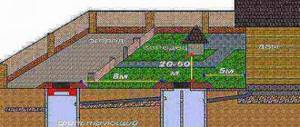In accordance with the provisions contained in the updated edition of the set of rules for urban planning, redevelopment and development of urban and rural settlements, the distance between residential buildings and other buildings must comply with accepted standards. The purpose of these rules is to increase the level of public safety in structures, as well as ensure the safety of material property, referring to Federal Law No. 384, adopted on December 30, 2009. In addition, in accordance with Federal Law No. 261, approved on November 23, 2009, rules are necessary to increase the level of compliance with the standards and requirements of current European regulations and documents through the use of a single effective method for determining operational characteristics.
This document is used in the design and reconstruction of urban and including rural settlements. It includes a list of the main significant requirements for the development of proposed territories and the layout of real estate. More specific requirements are developed by regional legislative acts in the field of urban planning.
Referring to the current standards according to SNiP, it is important not only the safety and sustainability of the health and life of citizens, but also the rational use of existing national natural resources and the healthy environment, ensuring legislative safety for cultural and including historical monuments, protecting the city from the possible adverse effects of natural and man-made disasters.
Distribution of territorial zones
Each standard used to determine the distance directly between high-rise and other buildings necessarily takes into account the distribution of territories in the city. The peculiarities of operation, intended purpose, in accordance with urban planning regulations, and the presence of environmental and sanitary zones are taken into account. Separately, territories are allocated for general use, which can be occupied by streets, driveways, squares, embankments, roads, parks, reservoirs and other objects aimed at meeting the public needs of the population. You can learn about the procedure for exploiting public land from local authorities, since they are the ones who develop regional legislative acts.
Dear readers!
Our articles talk about typical ways to resolve legal issues, but each case is unique. If you want to find out how to solve your specific problem, please contact the online consultant form on the right →
It's fast and free!
Or call us by phone (24/7):
If you want to find out how to solve your particular problem, call us by phone. It's fast and free!
+7 Moscow,
Moscow region
+7 Saint Petersburg,
Leningrad region
+7 Regions
(toll-free call for all regions of Russia)
Urban planning activities may also be limited if there is a historical building nearby, a cultural reserve, an area where cultural and historical monuments are protected, a specially protected natural area, a coastal protective strip, an area with minerals, territory , where development is prohibited due to the possible occurrence of natural and man-made emergencies.
What guides the establishment of standards?
The standards that are adopted directly during the construction of real estate in the city largely depend on where exactly the planned objects are located. In urban conditions, the planning structure is formed taking into account:
- Compact placement and interconnection of land plots, certain zones, taking into account the level of their compatibility;
- Zoning and structural distribution of land in interaction with public centers and transport interchanges, utility systems;
- Effective use of territories, referring to their urban planning value;
- Comprehensive consideration of architectural traditions in urban planning, climatic conditions, and other features;
- Effective functioning, as well as development of life support systems, saving resources, protecting the environment and cultural and historical monuments;
- Natural Resources Conservation;
- Conditions to ensure that persons with disabilities have unhindered access to transport and social infrastructure.
In cities that have historical value, in order to calculate the distance between buildings, it is necessary to take into account that the planning structure and architectural appearance of a given locality cannot be changed.
Minimum Requirements
Minimum distances between residential buildings in cities are necessary to ensure fire safety and ensure structural integrity.
Thus, the standard for brick, concrete, that is, stone houses with concrete floors, suggests that the distance between them should be at least six meters. From the same house to a stone (concrete, brick), but with wooden floors - eight meters, and to a prefabricated building - ten. Accordingly, between two brick, concrete houses with wooden floors there cannot be less than eight meters, and in the case of prefabricated ones, they should be located ten to fifteen meters from each other and from other houses.
In addition, the adopted standard regarding a residential multi-storey building stipulates that it cannot be located less than ten meters from a gas control point with low pressure and less than fifteen meters from the same object with high pressure.
Even when developing regional rules, the administration refers to the above-mentioned SNiP, construction rules for low-rise buildings, fire safety requirements and areas for the location of communication systems.
Distance from the road to the house in the private sector
Documents to be taken into account when planning buildings:
Indication on the site plan of the distances from buildings to the road
- Land Code;
- Building regulations;
- Set of rules for rural settlements;
- Set of rules for garden cooperatives.
Owners of their personal plots believe that the placement of a fence is their personal matter - this is a big misconception. The distance from the fence to the residential building is determined by the boundaries of the allotment.
Diagram indicating the distances from the house to the road on the site
Drawing and layout of the site according to SNiPs
The minimum distance from the road to the fenced area is 5 meters. The boundaries of land plots are established by the local administration based on:
- building codes;
- fire safety standards;
- the required size of the sanitary area.
Before calculating what distance should be from a private house, you need to determine what passes near the site - a road or a roadway.
This is interesting: Postings in land tax accounting
An example of the location of areas near the roadway
Since these are completely different concepts, distance standards in relation to them are different. The roadway is a road surface for vehicle traffic, with a dedicated path for bicycles and mopeds. May have two or more lanes.
Drawing and distances from buildings to the roadway
A road is part of a road surface, with dedicated lanes for the movement of vehicles and pedestrians. In the territories of garden cooperatives, the minimum width of central and side passages within the red line should be, m:
- for central passages – 15 m;
- for side passages – 9 m.
The minimum permissible radius of curvature of the edge of the roadway is 6 meters. The driveways must have areas for passing vehicles with a length of at least 15 meters and a width of at least 7 meters.
Required distance from private buildings to the roadway and power lines
The rules stipulate that the road along which cars and trucks travel should not be narrower than 3.5 meters.
When houses are located on both sides, the distance between them should be 3.5 meters plus a lane free from vehicles for pedestrians. If there is a roadway near the house, only the road lane for vehicles is taken into account. The pedestrian trail is not developed. On the roadway, pedestrians move along the side of the road in accordance with traffic rules.
Other significant distances
In accordance with the requirements of the Town Planning Code of the Russian Federation and a number of current rules, the minimum distance is observed not only between multi-storey buildings, but also between other objects next to them.
So, for example, the distance from the driveway to the street cannot be less than three meters. The gap between the windows of a residential building and the windows of any other building should be from six meters, between the building and tall trees - from four meters, between the building and low-growing trees - from two meters. No less important are the utility systems, which should not come into contact with the foundation of the house. Thus, a distance of five meters is maintained from the foundation to the water supply and sewer pressure system, and from four to ten meters to the gas pipeline, depending on whether the pressure in the systems is low, medium or high. From power cables to the foundation - sixty centimeters, to communication channels - two meters, and to heating networks - you should be guided by the standards of SNiP 41-02-2003.
It is important to keep in mind that if any conflict situation is brewing, before filing a claim in court, you must consult an experienced lawyer and find out what regulations were in force at the time of construction of the disputed building.
Distance from residential buildings
In the private sector, the distance between a residential building and a store is 50 m. This minimum acceptable standard value is defined as the width of the sanitary zone. Measurements are taken from the foundation of a residential building and a retail outlet.
It is necessary to retreat more than 3 meters from the fence so that there is clear passage for firefighting vehicles. The gap between the store and the fence remains clear of bushes, trees and other plantings. It is prohibited to place any items or objects in the lane for emergency vehicles. The entrance to the store yard is from the other side.
The garbage dump should have free access for sewer trucks from the back of the supermarket, bypassing the front side of the building.
The norms for the location of a store from a residential building can be reduced to 30 m in the event that the windows of the residential building do not face the retail facility, but only a blank wall.
The frequency of placement of retail outlets is determined by the convenience of citizens. The store must be located within accessible proximity, more precisely, the walking distance that can be freely covered by a resident of a high-rise building, including elderly people. For public places visited daily, the distance should be no more than 500 m. Such objects include:
Enterprises that provide services to the population and are not visited every day can be located 1200 m away. These are such facilities as:
- bank;
- mail;
- pharmacy;
- dairy kitchen;
- clinic or hospital;
- repair shop for household appliances;
- cafe.
This group of service facilities also includes industrial goods stores.
Minimum rate
In gardening cooperatives, it is allowed to locate a retail outlet at a distance of 1 meter from the fence and on land plots, along their border, if the cooperative does not have a centralized sewerage system. The degree of fire resistance of buildings must be at least category 1.
This is important to know: What documents should the owner of the apartment have?
About territorial boundaries
When calculating the boundaries by territorial zones in the city, the rules of land use and construction must be taken into account, namely:
- The ability to combine different target zones within one territory;
- The functionality of the selected site, as well as the parameters and planning of its development in accordance with the master plans of the city, region, and municipal areas;
- Layout of the territory and the current target category;
- Planned changes to land boundaries, different target categories depending on urban layout;
- Eliminating the possibility of causing damage to immovable capital construction projects.
At the same time, for existing and planned buildings it is necessary to calculate the passage of the border. They will be determined by the main lines, lines of passages and streets that divide the traffic flow, by the red lines of the boundaries of land territories, lines dividing settlements within the municipality, internal municipal boundaries, demarcation lines of natural objects and others. Zones that are subject to special operating conditions and cultural heritage sites, in accordance with Russian legislation, may have diverging boundaries, so it is necessary to clarify them with the local administration.
SNiP requirements
In order for buildings and various structures to meet certain requirements, there is a whole set of norms and regulations (SNiP) that allows you to control some of the nuances during construction. These rules were developed back in the days of the USSR, but even today the document has not lost its force.
The distance can be found from SNiP
It is these standards that stipulate the distance between houses, buildings and other residential and non-residential buildings. But it is worth considering that the regulatory requirements are not uniform and may differ significantly depending on what kind of structure will be erected, where the construction is planned (in the city or outside it), etc.
Although the requirements of SNiP must be taken into account during construction and planning, the law does not provide for penalties for their violations.
But if the interests of neighbors are violated on one side or another, then the victims can solve this problem through the courts . For example, water from the roof flows into a neighbor’s garden and washes away the soil from the beds. Of course, no one will like this, and the neighbor may file a lawsuit. And if it is proven that any violations were committed during construction, the court will decide the case in favor of the plaintiff.
There are 2 types of borders
Boundary Definitions
Before understanding the rules and regulations for distances between houses, you should first understand some definitions.
There are two types of boundaries, which are virtual lines :
- Red line. So this feature began to be called due to the fact that this is the color it is indicated on the map in the cadastral document. This boundary separates common or municipal areas from private properties. Beyond the red line are all general communications (drains, water supply, gas pipelines, roads, communication lines). In accordance with the rules, any private buildings, including residential and courtyard ones, should not extend beyond its boundaries.
- Plot boundaries. This line separates the personal area from the neighbor's area. To divide the space, special boundary signs (columns) are installed at points where straight lines break. Very often, disputes over territory can flare up between neighbors. But such issues can be resolved with the help of a cadastral passport for a land plot, in which all boundaries must be indicated.
Of course, in practice, in order to prove your case and defend the boundaries of the site, sometimes one document is not enough. You have to seek the help of a land surveying specialist, and sometimes issues can only be resolved in court.
In this video you will learn more about the boundaries between areas:
Development rules
If the land plot is more than 6 acres in size, then all norms and rules must be complied with.
The minimum distance between private houses, according to the set of rules, should be :
- From the red line of the road to a residential building - 3 m, and from the street - 5 m.
- From the neighbor's fence to a residential building - 3 m.
- From the fence to buildings intended for keeping small and large domestic animals - 4 m.
- From a common fence with neighbors to outbuildings (this also includes a garage and a bathhouse) - 1 m.
- From the fence to large tree-like plants - 2 m, to bushes - at least 1 m.
And also we must not forget about the roofs, which should not protrude more than 0.5 m. In some cases, the distance between houses during construction should be increased, but it all depends on the building material and its fire-fighting properties.
General distribution of building plots
The planning structure of a residential area provides not only the distance between apartment buildings, but also the formation of infrastructural development in accordance with the urban planning plan as a whole, as well as the natural features of the territory. Moreover, it is important to provide for the relationship between located real estate objects, public buildings and structures, road networks, their landscaping in common areas, and other objects that can be placed in a residential area in accordance with sanitary and hygienic standards and safety rules.
Since the development of individual regions affects the entire country, it is equally important to pre-determine the overall size of the residential area. In a city where the average number of floors of a residential apartment building is up to three floors, ten hectares are allocated for development if the development is without a land plot, and twenty if with a plot. For cities with houses from 4 to 8 floors this is 8 hectares, for cities with houses of 9 floors or more - 7 hectares. At the same time, it is forbidden to place objects of urban significance in a residential block or microdistrict, as well as to develop transit passages through the territory, which are united by a common yard. The territory of a group of residential apartment buildings usually does not exceed 5 hectares.
Requirements for fire safety distances between buildings and structures
Created: September 19, 2016
Fire distance or fire gap is the distance established by current regulatory documents between buildings and structures, intended to prevent the spread of fire.
The most important requirements for the fire safety distances under consideration are established by Federal Law No. 123-FZ of July 22, 2008 “Technical Regulations on Fire Safety Requirements.” This is how they determine the distances between fire and explosion hazardous objects and other objects. Explosion and fire hazardous facilities include hazardous production facilities where fire and explosive substances and materials are produced, used, processed, formed, stored, transported, and destroyed. The distance between such objects and preschool educational organizations, general education organizations, medical organizations, and recreational institutions must be at least 50 m.
Also, the federal law determines the distances to objects (including forest areas and forest parks) bordering oil and petroleum product warehouses, gas stations, liquefied petroleum gas warehouses and liquefied petroleum gas tank installations. Fire distances from these objects to adjacent buildings, structures and other objects are determined individually depending on a number of their parameters (usually volume). In this case, it is allowed to reduce the specified fire distances (with the exception of residential, public buildings, children's and sports grounds) when using fire barriers, which include fire walls, fire curtains, curtains and screens, fire water curtains and fire mineralized strips. In this case, the calculated value of fire risk should not exceed the permissible value of fire risk established by Federal Law No. 123-FZ of July 22, 2008 “Technical Regulations on Fire Safety Requirements.”
Separately, the federal law stipulates that fire distances from objects critical to the national security of the Russian Federation to the boundaries of forest areas and forest parks must be at least 100 meters.
Other requirements for fire safety distances are set out in the Code of Practice SP 4.13130.2013 “Fire protection systems. Limiting the spread of fire at protection facilities. Requirements for space-planning and design solutions.” In accordance with it, the main criterion for the size of the fire safety distance is the degree of fire resistance of the building - a classification characteristic determined by the fire resistance limits of structures, which in turn depend on the time of their destruction from fire exposure.
Depending on the degree of fire resistance, the distances between buildings can vary from 6 to 18 m. In some cases, for example, if there are no windows in the walls of adjacent buildings or when each building is equipped with automatic fire extinguishing systems, these distances can be reduced by 25 or 50 percent. Fire distances between wooden buildings or buildings with unprotected load-bearing metal structures located in northern territories (in climatic subregions IA, IB, IG, ID and IIA) must be increased by 50 percent. It is also necessary to increase fire safety distances between wooden two-story buildings by 20 percent.
Between the most fire-resistant residential and public buildings (buildings of I, II and III degrees of fire resistance) fire distances are not standardized if the wall of a higher or wider building facing the neighboring building is fire-resistant. Fire safety distances between public buildings (except for the buildings of kindergartens, hospitals, schools and similar institutions) are not standardized when the total area within the perimeter of the building does not exceed the permissible floor area within the fire compartment. Also, fire safety distances are not standardized between a residential building and outbuildings or between outbuildings within the same garden, dacha or household plot of land. The same applies to semi-detached houses located on two adjacent plots, as well as when outbuildings are located in a group on an area of no more than 800 square meters, subject to the required distances between semi-detached houses or groups.
Compliance with the requirements for fire safety distances helps prevent fire from spreading to neighboring buildings, ensuring the protection of life and health of citizens located in them, and the safety of the property of individuals and legal entities.
Comments
- Comments
- In contact with
Download SocComments v1.3
Add a comment
JComments
Permissible building density in the city
For cities, the population density of territories is no less important. The accepted standards are given above:
| Territory zone | Coefficient value - density |
|
|
|
|
|
|
Experimental fields and testing grounds, reserve territories and sanitary protection zones are not taken into account. However, only specialists can help calculate the density in a particular case.









